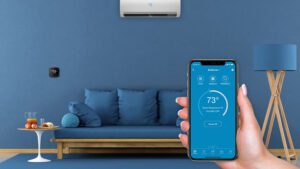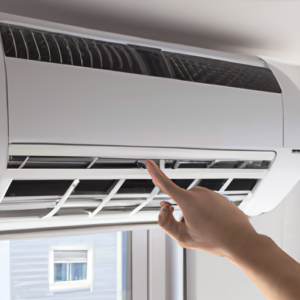If you’re considering a ductless mini-split system for your heating and cooling needs, you may be wondering if you can control the temperature in each room separately. The answer is yes. A ductless mini-split system offers individual room control, allowing you to customize the temperature settings in different areas of your space. This feature not only provides personalized comfort for each occupant but also helps optimize energy efficiency by only heating or cooling rooms that are in use. Whether it’s your residential home, garage, work shed, or a large warehouse, a ductless mini-split system can offer the flexibility and control you desire.
1. Overview of Ductless Mini-Split Systems
1.1 Definition and Functionality
Ductless mini-split systems, also known as ductless heat pumps or ductless air conditioners, are HVAC systems that provide both heating and cooling capabilities without the need for ductwork. These systems consist of an outdoor unit, which houses the compressor and condenser, and one or more indoor units, which are responsible for delivering conditioned air to individual rooms or zones.
1.2 Advantages of Ductless Mini-Split Systems
One of the primary advantages of ductless mini-split systems is their flexibility in providing room-to-room temperature control. Unlike traditional central heating and cooling systems, which rely on a single thermostat to control the temperature of the entire home or building, ductless mini-split systems allow you to customize the comfort levels in each room separately. This level of precision ensures that each occupant can enjoy their desired temperature setting, promoting individualized comfort.
Additionally, ductless mini-split systems offer easy installation compared to traditional systems that require expensive ductwork. This makes them an ideal solution for retrofitting older homes or buildings, or for adding heating and cooling capabilities to areas where ductwork is not feasible or desired.
1.3 Applications of Ductless Mini-Split Systems
Ductless mini-split systems can be used in a wide range of applications. They are commonly employed in residential homes, where they provide efficient and personalized heating and cooling to individual rooms or zones. They are also popular in commercial settings such as offices, hotels, and retail spaces, where different temperature requirements may exist throughout the building.
These systems are also highly suitable for garages, work sheds, and even large buildings like warehouses, where maintaining a consistent temperature within specific areas is essential. The ability to control the temperature in each room separately allows for optimized comfort and energy efficiency in diverse environments.
2. Understanding Zoning in Ductless Mini-Split Systems
2.1 Zoning Defined
In the context of ductless mini-split systems, zoning refers to the ability to divide a building into different temperature zones, each with its own individual control. This means that you can set different temperatures in each zone based on the occupants’ preferences, the room’s usage, or the desired energy efficiency. Zoning allows for precise temperature control and enhanced comfort in multi-room environments.
2.2 Zoning Components
To achieve effective zoning in a ductless mini-split system, several components are required. These include the indoor units, also known as air handlers, which deliver conditioned air to each zone. Each air handler can be individually controlled, allowing for customized temperature settings. The outdoor unit, which contains the compressor and condenser, connects to the indoor units via refrigerant lines and transfers the heat or cooling energy between the indoors and outdoors. Finally, a control system, typically in the form of a thermostat or a smart controller, allows you to set and adjust temperature settings for each zone.
2.3 Zoning Benefits
The benefits of zoning in a ductless mini-split system are numerous. By dividing a building into different temperature zones, you can tailor the comfort levels to individual preferences and usage patterns. For example, you can set a lower temperature in bedrooms at night for optimal sleeping conditions, while keeping living areas at a slightly higher temperature during the day.
Zoning also enables increased energy efficiency, as you can selectively heat or cool only the occupied zones, avoiding unnecessary energy consumption. This targeted approach to heating and cooling can lead to significant cost savings over time.
Moreover, with zoning, you can effectively address temperature variations that may occur due to factors like solar heat gain, room orientation, or occupancy changes. This ensures consistent and comfortable temperatures throughout the building, even in areas that are prone to fluctuations.

3. How Ductless Mini-Split Systems Achieve Room-to-Room Temperature Control
3.1 Individual Air Handlers and Controls
The key to achieving room-to-room temperature control in a ductless mini-split system lies in the individual air handlers and controls. Each indoor unit is equipped with its own thermostat or control panel, allowing occupants to set and adjust the temperature according to their preferences. This means that each room or zone can have its own unique temperature setting, independent of the others.
3.2 Communication between Units
To ensure that the temperature settings are accurately maintained across the system, the indoor units in a ductless mini-split system communicate with each other and with the outdoor unit. This communication allows for coordinated operation and efficient energy transfer. For example, if one indoor unit detects a significant drop in temperature, it may request additional heating from the outdoor unit to reach the desired setpoint.
3.3 Variable Refrigerant Flow Systems
Many ductless mini-split systems utilize variable refrigerant flow (VRF) technology to achieve room-to-room temperature control. VRF systems employ advanced refrigerant control mechanisms that allow for precise modulation of cooling and heating capacities. This means that the system can match the exact cooling or heating demands of each zone, resulting in optimal comfort levels.
3.4 Importance of Proper Sizing
Proper sizing is crucial for achieving effective room-to-room temperature control in a ductless mini-split system. Each zone’s cooling and heating needs must be accurately assessed to determine the appropriate capacity of the indoor and outdoor units. Oversized or undersized units can result in energy inefficiency, comfort issues, or even system malfunctions. Consulting with a professional HVAC contractor is essential to ensure correct sizing and maximize the performance of the system.
4. Factors to Consider for Room-to-Room Temperature Control
4.1 Number and Placement of Air Handlers
To achieve optimal room-to-room temperature control, careful consideration must be given to the number and placement of air handlers. The number of air handlers needed depends on the number of zones or rooms you wish to control separately. Each room or zone should have its own dedicated air handler to ensure precise temperature regulation.
The placement of air handlers is crucial to achieve uniform comfort. Factors such as room layout, occupancy patterns, and furniture arrangement should be taken into account when determining the ideal location for each air handler. Placing the units in centrally accessible areas, away from obstructions, can help maximize their effectiveness.
4.2 Insulation and Air Leaks
Insulation and air leaks play a significant role in the effectiveness of room-to-room temperature control. Proper insulation reduces heat loss or gain through the walls, ceilings, and floors. It helps maintain consistent temperatures within each room or zone and reduces the workload on the ductless mini-split system.
Air leaks can occur through gaps or cracks in windows, doors, or other openings. These leaks allow conditioned air to escape and outdoor air to infiltrate, leading to temperature imbalances. Identifying and sealing air leaks is essential for maintaining accurate temperature control throughout the building.
4.3 Load Calculation and Thermal Needs
Conducting a load calculation is crucial to determine the cooling and heating requirements of each room or zone. Factors such as room size, insulation levels, window orientation, and heat-generating appliances must be considered. Load calculations help determine the appropriate capacity of the ductless mini-split system and ensure that each zone receives the necessary amount of cooling or heating.
Understanding the thermal needs of each room or zone is also important. Rooms with different thermal characteristics, such as high ceilings, large windows, or southern exposures, may have distinct cooling or heating requirements. By considering these factors, you can create customized temperature settings that maximize comfort and energy efficiency.
4.4 Energy Efficiency and Cost Considerations
When aiming for room-to-room temperature control, energy efficiency and cost considerations should not be overlooked. While ductless mini-split systems are generally energy-efficient compared to other HVAC systems, optimizing their performance is crucial for minimizing energy consumption and utility bills.
Choosing energy-efficient models, properly maintaining the system, and implementing energy-saving practices, such as setting temperature setbacks during unoccupied periods, can significantly impact energy costs. Additionally, choosing a system with high seasonal energy efficiency ratio (SEER) and heating season performance factor (HSPF) ratings ensures long-term energy savings and reduced environmental impact.

5. Installation and Setup of a Ductless Mini-Split System with Individual Room Control
5.1 Professional Installation
Professional installation is highly recommended for ductless mini-split systems, especially when aiming for individual room control. HVAC contractors experienced in ductless systems can assess the specific cooling and heating requirements of your building and recommend the most suitable system configuration. They will ensure proper unit sizing, optimum placement, and correct installation of refrigerant lines, drain lines, and electrical connections.
5.2 Proper Sizing and Load Calculation
As previously mentioned, proper sizing is critical for achieving efficient and effective room-to-room temperature control. A professional HVAC contractor will conduct load calculations to determine the cooling and heating needs of each zone. Based on these calculations, they will recommend the appropriate capacity for the outdoor and indoor units to ensure optimal comfort and energy efficiency.
5.3 Determining the Number of Air Handlers
The number of air handlers required for a ductless mini-split system depends on the desired number of temperature zones or rooms. A thorough assessment of your building’s layout and usage patterns will help determine the optimal number and placement of air handlers. By discussing your specific requirements with an HVAC professional, you can ensure that each room receives individual temperature control.
5.4 Placement and Zoning Strategy
The placement of air handlers is crucial to achieve proper room-to-room temperature control. HVAC contractors consider factors such as airflow distribution, furniture placement, expansion capabilities, and aesthetic preferences when determining the ideal locations for the units. They will strategically position the air handlers to ensure even coverage and effectiveness in delivering conditioned air to each space.
The zoning strategy will also be established during installation. Based on room layout, occupancy patterns, and thermal characteristics, the HVAC contractor will define the individual temperature control zones and program the control system accordingly. Collaboration between the contractor and the building’s occupants is essential to ensure that the zoning strategy aligns with their comfort requirements and preferences.
6. Using Zone Controls and Thermostats in Ductless Mini-Split Systems
6.1 Smart Thermostats and Wireless Controls
To enhance the usability and convenience of room-to-room temperature control in a ductless mini-split system, smart thermostats and wireless controls can be integrated. Smart thermostats offer advanced features such as Wi-Fi connectivity, remote access, and compatibility with voice assistants or mobile applications. With these technologies, you can conveniently set and adjust temperature settings from anywhere in the building, using your smartphone or other smart devices.
Wireless controls provide flexibility in terms of thermostat placement. They allow you to position the thermostats wherever they are most convenient for occupants, rather than being limited to a fixed location. This freedom of placement ensures that the temperature sensors accurately represent the temperature in each respective room or zone.
6.2 Individual Temperature Settings
The ability to set individual temperature settings in each room or zone is a key feature of ductless mini-split systems. With zone controls and thermostats, occupants can easily tailor the temperature to their liking, ensuring personalized comfort throughout the building. This individualized temperature control eliminates the need for compromise, allowing each occupant to create their own comfortable environment.
6.3 Scheduling and Programmability
Another advantage of using zone controls and thermostats is the ability to create schedules and programming based on occupancy patterns. This allows you to automate temperature adjustments throughout the day, ensuring optimal comfort during occupied periods and energy savings during unoccupied periods. By programming the system to raise or lower temperatures according to your daily routines, you can achieve a balance between comfort and energy efficiency without manual intervention.
6.4 Remote Access and Monitoring
With smart thermostats and wireless controls, remote access and monitoring capabilities are available, providing convenience and peace of mind. These features enable you to remotely control the temperature settings in each room or zone, even when you are away from the building. Additionally, many smart thermostats offer energy usage tracking and reporting, allowing you to monitor the system’s performance and identify potential energy-saving opportunities.

7. Benefits and Considerations of Room-to-Room Temperature Control
7.1 Comfort and Personalized Settings
Room-to-room temperature control offers enhanced comfort and personalized settings for occupants. By allowing individuals to adjust the temperature in their own spaces, preferences can be met without sacrificing the comfort of others. Each occupant can enjoy their desired temperature, promoting overall satisfaction, productivity, and well-being.
7.2 Energy Efficiency and Savings
One of the significant benefits of room-to-room temperature control is improved energy efficiency. By selectively heating or cooling only the occupied areas, energy consumption can be reduced compared to traditional central heating and cooling systems. This targeted approach to temperature control can lead to significant cost savings on energy bills over time.
7.3 Improved Air Quality
Room-to-room temperature control can also contribute to improved indoor air quality. By operating each zone independently, the ductless mini-split system can filter and circulate air more efficiently. This helps remove allergens, pollutants, and odors from the air, providing cleaner and healthier indoor environments.
7.4 Potential Challenges and Limitations
While room-to-room temperature control offers numerous benefits, it’s important to be aware of potential challenges and limitations. Proper installation, sizing, and maintenance are essential to ensure optimal system performance. Additionally, zoning strategies should be carefully planned to avoid temperature imbalances or conflicts between different zones. Consulting with a professional HVAC contractor and regularly maintaining the system can help mitigate these challenges and maximize the benefits of room-to-room temperature control.
8. Maintenance and Care for Ductless Mini-Split Systems
8.1 Regular Filter Cleaning or Replacement
Proper maintenance and care are crucial for the efficient and reliable operation of ductless mini-split systems. One essential maintenance task is the regular cleaning or replacement of air filters. Filthy filters can restrict airflow, reducing system performance and potentially leading to premature wear and tear. Following the manufacturer’s recommendations, clean or replace the filters at least once every three months, or more frequently if the system is subjected to significant dust or debris.
8.2 Scheduled Maintenance by Professionals
In addition to regular filter maintenance, scheduling professional maintenance by HVAC technicians is highly recommended. Professional maintenance ensures that the system is operating at peak performance and helps identify and address any potential issues before they become major problems. During maintenance visits, technicians inspect the system, clean the components, check refrigerant levels, and perform any necessary adjustments or repairs. Regular professional maintenance can prolong the lifespan of the system and optimize its energy efficiency.
8.3 Monitoring and Troubleshooting
Regular monitoring and troubleshooting of the ductless mini-split system are essential to address any performance issues promptly. Monitoring capabilities provided by smart thermostats or wireless controls enable you to keep an eye on temperature settings, energy usage, and system status. This allows you to identify abnormal behavior or potential malfunctions and take appropriate actions. Troubleshooting can involve simple tasks such as checking for error codes, ensuring power supply and connectivity, and calling for professional assistance if needed.

9. Conclusion
Ductless mini-split systems with room-to-room temperature control offer a versatile and efficient solution for customized heating and cooling. By dividing a building into individual temperature zones, occupants can enjoy personalized comfort levels, while energy efficiency is maximized by selectively conditioning only the occupied spaces. Proper installation, sizing, and maintenance are crucial for optimal performance and longevity.
With smart thermostats and wireless controls, the convenience of adjusting temperature settings remotely and programming the system to suit daily routines is available. This level of control enhances comfort, saves energy, and promotes better indoor air quality. While there may be challenges and limitations, collaborating with an HVAC professional and following a comprehensive maintenance plan can overcome these hurdles and ensure the benefits of room-to-room temperature control are realized.

